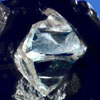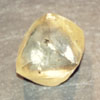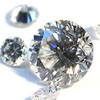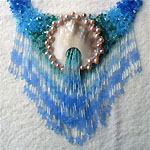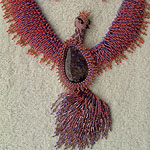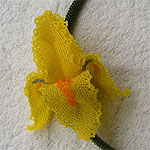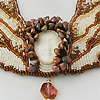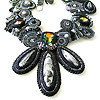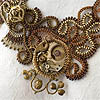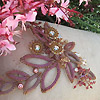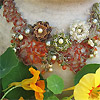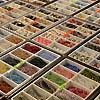April, 2010

Happy Springtime!Happy Springtime, our dear friends! Read in April's issue of MyLovelyBeads.com newsletter:
Diamonds are forever
Contact us with any questions at
info@mylovelybeads.com.
Fashion Colorworks 2010 Featured artist - Beverly Choy Steampunk jewelry Inspired by flowers - Angelika Motzkin Step by step - Netting base embroidery May upcoming events Best regards,
MyLovelyBeads.com Team |
Diamonds are foreverAs well as clear quartz, a gemstone for April is diamond. Diamond (from the ancient Greek ADAMAS, meaning unbreakable, proper, or unalterable) is one of the best-known and most sought-after gemstones. Diamonds have been known to humankind and used as decorative items since ancient times; some of the earliest references can be traced to India. Diamond's hardness and high dispersion of light - giving the diamond its characteristic "fire" - make it useful for industrial applications and desirable as jewelry. Diamonds are such a highly traded commodity that multiple organizations have been created for grading and certifying them based on the four Cs, which are carat, cut, color, and clarity. Other characteristics, such as shape and presence or lack of fluorescence, also affect the desirability and thus the value of a diamond used for jewelry. The carat weight measures the mass of a diamond. One carat is defined as 200 milligrams (about 0.007 ounce avoirdupois). The point unit equal to one one-hundredth of a carat (0.01 carat, or 2 mg) is commonly used for diamonds of less than one carat. All else being equal, the price per carat increases with carat weight, since larger diamonds are both rarer and more desirable for use as gemstones. Clarity is a measure of internal defects of a diamond called inclusions. Inclusions may be crystals of a foreign material or another diamond crystal, or structural imperfections such as tiny cracks that can appear whitish or cloudy. The number, size, color, relative location, orientation, and visibility of inclusions can all affect the relative clarity of a diamond. The most fine quality as per color grading is totally colorless which is Graded as "D" color diamond across the globe which means it is absolutely free from any color. The next is very slight traces of color, which can be observed by any expert diamond valuer/grading laboratory. Diamonds, which show very little traces of color, are graded as E, F, G or H color diamonds. Slightly colored diamonds are graded as I or J or K colors. A diamond can be found in any other color also other than colorless. Some of the color diamonds such as pink are very rare diamonds and are priceless. Diamond cutting is the art and science of creating a gem-quality diamond out of mined rough. The cut of a diamond describes the manner in which a diamond has been shaped and polished from its beginning form as a rough stone to its final gem proportions. Often diamond cut is confused with "shape". The most famous use of the diamond in jewelry is in engagement rings, which became popular in the early to mid 1900s due to an advertising campaign by the De Beers company, though diamond rings have been used to symbolize engagements since at least the 15th century. The diamond's high value has also been the driving force behind dictators and revolutionary entities, especially in Africa, using slave and child labor to mine blood diamonds to fund conflicts. |
||||||
Fashion Colorworks 2010One of the contest jurors, Kerrie Slade, said, "Now, there are lots of good reasons to have a go at this contest, not only is it a great personal challenge to work in set color combinations, but it's free to enter, it's open to international entrants, judging is from photos only (so you don't have to worry about packing and posting your creation) and there are prizes to be won - how many beading contests can say all of that?" The contest continues, you can submit your entries for the Fashion Colorworks 2010 Beading Contest until June 15. We are looking forward to seeing your amazing beaded objects at the contest!
|
||||||
Featured artist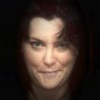
Our featured artist today, extraordinary beadworker Beverly Choy is from Richmond, Texas. Beverly started beading back in 2001, about a year after she had been diagnosed with bipolar disorder. Her mom had a container of beads for embellishing her sewing and Beverly looked at them and asked if she could borrow the container for a few days. Beverly had a tattoo of a koi fish in mind and knew nothing about bead embroidery or beading, but she knew she wanted to bead one. Four days later, her fish was done and she was absolutely hooked on beading! Beverly says, "I spent the next year learning everything I could online, then started finding magazines and books at the local bead shops. Talk about being in heaven! I progressed into making beaded collars, teaching myself different techniques, finding out what worked for me and what didn't, but bead embroidery remained my favorite for years. I now have two favorite techniques, bead embroidery and freeform. I think I moved towards freeform because my thoughts aren't always organized enough to stick with bead embroidery all the time. It was a struggle to do freeform, at first. It's not easy to give up the structure and symmetry, but the longer I practiced freeform, the more I began to love it and the more it helped me get through the days where I couldn't focus on any one technique. When I need inspiration for a piece, I love looking at ladies blouses and outfits. There are also the fabrics at the stores that inspire me. Some of the colors that are put together can be outlandish, but when transferred to beads, they are absolutely stunning. Looking at the beadwork of other beaders is also a great way to get inspiration. A lot of times, seeing someone mixing certain techniques together will give me idea's for a piece of my own. Sherry Serafini's "Mermaids Attire" brought tears to my eyes when I first saw it. It was just such an explosion of techniques and texture, toned down with the completeness of turquoise being the overall color, that I was just overwhelmed with ideas. Laura McCabes' work is so intricate and structured. Heidi Kummli's use of earthy colors and her vision of nature are just exquisite. The bead embroidery techniques of Robin Atkins grabbed me when I first found her and I still go back and have to check her books out for inspiration. There are so many beaders that visit Beki Haley's forum "All About Beads" and post their works, that it'd be impossible to list them all here. Everyone shares their finished work and is so helpful to those who are just learning, that it's a treat to log in every day..."
Full article by Beverly Choy
|
||||||
Steampunk jewelryDo you get tired of wearing gold jewelry? Don't you want a beaded necklace? Are you looking for unusual piece of jewelry? Ok, buy or create a Steampunk article! Steampunk is a sub-genre of science fiction and speculative fiction, frequently featuring elements of fantasy, which came into prominence in the 1980s and early 1990s. The term denotes works set in an era or world where steam power is still widely used - usually the 19th century, and often Victorian era England - but with prominent elements of either science fiction or fantasy. Steampunk has a bit of an obsession with time. As such, watches of all types, including wristwatches and pocketwatches, are popular. In fact, clock parts are often used in the construction of individual pieces of steampunk jewelry. Gears and watch hands are used to decorate larger pieces. Old-fashioned keys are also very popular, as are bits of antique cast-offs, such as pill cases, thread cutters and tiny knives. Although it does exist, you will rarely find colors such as gold or silver in steampunk jewelry. In order to reflect an antique feel, steampunk avoids the use if these bright, new colors. Instead, favored colors are brass, bronze, copper and dark silvers such as gunmetal, brushed aluminum and titanium. Black and white is not popular; ecru, rich browns and shades of gray are much more common. If you're thinking of creating steampunk jewelry and looking for some parts, you can surf well known suppliers' websites, for instance, Artbeads.com. Much more parts you can find on Etsy, my favorite seller is amystevensoriginals. And the latest good news for steampunk jewelry makers - Soft Flex Company announced another Flex Your Creativity Beading Contest! The company is looking for Steampunk designs using its beading wire. All entries must be received by September 1, 2010, and prizes are exciting. |
||||||
Inspired by flowers
Born in Belorussia, Angelika Motzkin lives in Ashkelon, Israel. She graduated from the College of Arts with a degree in Crafts, and then worked as a teacher. Angelika made a great success, and already in 1980s took part in many national and international exhibitions. She learned many techniques, but beading. In early 1990s Angelika moved to Israel, and was enrolled in another College of Arts, in the city of Ramat Gan, where she improved her crafting skills. Angelika felt free working with different media and continued teaching. She found in shops a lot of new unusual materials and wanted to try everything, one day beads caught her eye, and she fell in love with beading. Angelika was lucky enough; her first tutorial in beading was the infamous "White Russian Beading" Book by M. Anufrieva. Learned main techniques, being a creative person Angelika soon started her own designs. Except beading and crafting, Angelika has one more passion; it's her small flower garden. And there is no wonder, that flowers inspire Angelika, giving her themes for her beadwork. Another source of Angelika's inspiration is the nature of Israel, its history, and everything else associated with that. Once Angelika created a collection of jewelry featuring caves, jugs, sand, and pitchers. As a rule, Angelika uses pastel tones, her favorite color is green and any shades of green. She likes the sea, and features it in many works using pearls, shells, and corals. Angelika spend much time teaching other beadwork lovers, she helped many talented designers, one of them is well known in beading world Miriam Shimon. Angelika says, that she is grateful to Gloria Landau, the owner of the shop "BOGAL", who supports her in learning fashion trends and in researching new materials for beading. Angelika took part in many exhibits in Israel, Russia, and Ukraine. Last year Angelika was juried into the Bead Dreams final in Seed Bead Jewelry category, and her Opal Fantasy Necklace was exhibited in Milwaukee, WI. Angelika says, that one of her greatest success is the exhibition in the Tokyo Municipal Museum in Japan in 2009, where three her beadworks were showcased. We wish Angelika further success!
Gallery of bead artwork by Angelika Motzkin
|
||||||
Step by step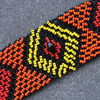
Another small tutorial by Victoria Katamashvili is about netting base embroidery. "It's as easy as one-to-three," says Victoria, and your plain bracelet transforms into attractive piece of jewelry!
Tutorial by Victoria Katamashvili: Netting base embroidery
|
||||||
Upcoming events
Columbus, OH - May 7-9 The International Gem & Jewelry Show offers the greatest selection and lowest prices on diamonds, gold, silver, beads, and more. Choose either costume or fine jewelry from more than 350 exhibitors from around the world. |
||||||
Note
If you don't see the newsletter properly formatted please click here:
April Issue
|
||||||
© 2010 MyLovelyBeads.com All Rights Reserved.
If you do not want receive our newsletter and you wish to remove your email address from our mailing list, please click the following link to unsubscribe.



